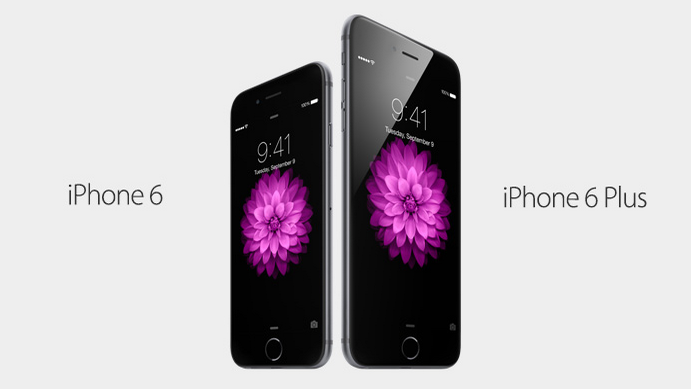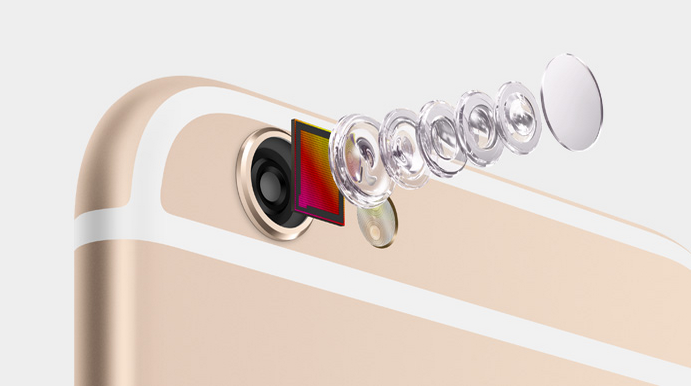Apple has launched two new iPhones, the 4.7-inch iPhone 6 and the 5.5-inch iPhone 6 Plus. Along with larger screens and a completely new iPad-style design with an ultra thin body and rounded corners, the two new phones offer faster processors, better cameras, and Apple’s new Apple Pay payment system.
Apple’s new iPhones are available in Gold, Silver, and Space Gray, and are available in 16, 64, and 128 GB capacities. The iPhone 6 pricing starts at $199 on contract, while the iPhone 6 Plus pricing starts at $299.
 While both models include the same 64-bit A8 chip and the same general design, there are several differences between the two phones. The iPhone 6 measures in at 6.9mm, while the iPhone 6 Plus is slightly thicker at 7.1mm. Apple’s iPhone 6 Plus also has three major differentiating factors: optical image stabilization for the camera, and a longer battery life, and an iPad-style landscape modethat displays more content on the screen.
While both models include the same 64-bit A8 chip and the same general design, there are several differences between the two phones. The iPhone 6 measures in at 6.9mm, while the iPhone 6 Plus is slightly thicker at 7.1mm. Apple’s iPhone 6 Plus also has three major differentiating factors: optical image stabilization for the camera, and a longer battery life, and an iPad-style landscape modethat displays more content on the screen.
Though the iPhone 6 Plus has optical image stabilization, both phones got some major camera improvements in form of sensor upgrades, improved tone mapping, better noise reduction, and new “Focus Pixel” technology, which improves the phone’s ability to select autofocus points. For videos, there’s a new 240fps slo-mo option, along with support for shooting in 1080p at 60fps. The front-facing camera was also upgraded, with an f/2.2 aperture that lets in more light and new burst mode capabilities.
 Both phones have an impressive new “Retina HD Display,” with the iPhone 6 featuring a resolution of1334 x 750 (326 ppi) and the iPhone 6 Plus featuring a resolution of 1920 x 1080 (401 ppi).
Both phones have an impressive new “Retina HD Display,” with the iPhone 6 featuring a resolution of1334 x 750 (326 ppi) and the iPhone 6 Plus featuring a resolution of 1920 x 1080 (401 ppi).
Design wise, the phones more closely resemble the iPad and the iPod touch than the iPhone 5s. Both models have soft, rounded corners and a curved glass screen that melds smoothly into the thin metal body of the device. The volume buttons on the left side of the device are now pill-shaped, and the power button is located on the right side of the device for easier one-handed use.
To further make its devices easier to use one-handed, Apple has added in a new double tap home button gesture called “Reachability,” which moves items from the top of the screen to the bottom of the screen for quick access.
Other new features in the iPhone 6 and iPhone 6 Plus include WiFi calling support, faster 802.11ac WiFi, and support for Voice over LTE (VoLTE).
Reviews
Apple provided multiple publications with early iPhone 6 and 6 Plus review units. The embargo has now lifted on review posts, so we have gathered some of the relevant excerpts from each site in order to highlight general release reactions to Apple’s iPhone 6 and 6 Plus.
Apple’s two new devices are essentially identical in design aside from the difference in screen size and the battery life/optical image stabilization in the iPhone 6 Plus. One notable improvement in both devices is the longer battery life afforded by the larger batteries. The iPhone 6 Plus is said to last up to 2 days, while the iPhone 6 may last a day and a half.
Brad Molen, Engadget:
Both iPhones are thinner than their predecessor. Whereas the 5s was 7.6mm thick, the 6 comes in at 6.9mm, with the 6 Plus measuring a hair thicker at 7.1mm. I don’t always subscribe to the “thinner is better” mantra, but it’s a benefit in this case because larger iPhones wouldn’t feel as comfortable if they had the same shape as the 5s. If I had to choose based on in-hand feel alone, I’d pick the 6 over the Plus. I can still wrap my fingers around the 6 just as easily as I could with the 5s (and its curved sides don’t cut as sharply as the edges on the 5s), but the large-screened 6 Plus is… well, it’s manageable.
David Pierce/Nilay Patel (iPhone 6, iPhone 6 Plus), The Verge:
Huge phones get to have huge batteries, and the iPhone 6 Plus is a huge phone with a huge battery: I consistently got about two days of battery life from the 6 Plus in regular daily use — slightly more than the day and half we got from the iPhone 6, and basically the same as the Note 3.
Walt Mossberg/Lauren Goode (iPhone 6, iPhone 6 Plus), Re/code:
In my tests, I found the iPhone 6’s Wi-Fi speeds — both downstream and upstream — were roughly double those of the 5s, and about 25 percent faster than those of the Samsung Galaxy S5. But I saw little difference in LTE speeds, either on Verizon or AT&T.
Jim Dalrymple, The Loop:
The 6 Plus was awkward for me to use at first–it was kind of like using a smaller version of the iPad mini, but it was a phone. I had a hard time wrapping my head around the idea of using it on an ongoing basis, but the larger screen eventually won me over.
HARSHVARDHAN SINGH.



47 Comments